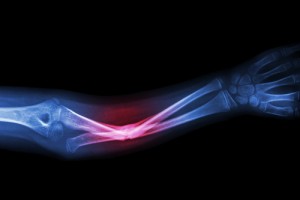Jersey City, NJ Accidental Injuries, Part One: Spotlight on Broken Bones
Posted April 12th, 2016 by Anthony Carbone, PC.
Categories: Personal Injury.
 “Sticks and stones may break my bones.” Almost all of us are familiar with the childhood rhyme. As personal injury lawyers, we can tell you that it’s more than sticks and stones hurting people. There are car crashes, slip and fall accidents and more that account for broken bones.
“Sticks and stones may break my bones.” Almost all of us are familiar with the childhood rhyme. As personal injury lawyers, we can tell you that it’s more than sticks and stones hurting people. There are car crashes, slip and fall accidents and more that account for broken bones.
Obviously, we are not physicians. However, we think our clients need to learn the basics. This article is the first in a series on different types of injuries. Your treating doctor should always be your primary resource when it comes to diagnosis and treatment.
All Types of Fractures
Sally was involved in a car accident. She is transported to the emergency room by ambulance. After x-rays, her arm is put in a sling and provided with a diagnosis. Sally’s friend is alarmed when she sees her. The conversation goes something like this:
Friend: “Oh wow! What happened? Did you break your arm?
Sally: “No, I fractured it.”
You may have guessed it. Sally’s answer is both right and wrong. If you are diagnosed with a fracture, you’ve broken a bone. The same is true for cracked bones. They all are different ways of saying a bone has been broken!
Broken bones often come with different descriptive terms. Of course, one will always refer to the affected body part. It may also involve specifying the type of fracture. We’re happy to give you a quick summary on a variety of fractures as presented by the American Academy of Orthopedic Surgeons:
- Stable fracture: If there is a “better” type of fracture, this wins the prize. A stable fracture responds well to immobilization. Once a cast or splint is applied, the injury should heal and the bone return to its proper placement.
- Open Compound fracture: Did your bone actually pierce through the skin? If you can visualize your broken bone on the outside, it falls into this category. This type of fracture could also mean that the skin around your injury is exposed, but your bone hasn’t necessarily poked through it.
- Transverse fracture: This type of fracture runs perpendicular to the long part of the bone.
- Oblique fracture: The break appears to be diagonal or crossways.
- Comminuted fracture: A bone may shatter into multiple pieces. If so, it is a comminuted fracture. These types of breaks require surgical repair.
Broken Bones are Serious Injuries
There is no doubt. A broken bone can be a serious injury. It can put major restrictions on your mobility immediately following an accident. It can also be the impetus for traumatic arthritis in the future.
It is important to seek medical help as soon as possible for any type of fracture. Let diagnostic tests and doctors decide the extent of your injuries. Treatment can include a cast, surgery and subsequent physical therapy.
If you have suffered any type of broken bone as a result of an accident, we would like to speak with you. At the Law Offices of Anthony Carbone, we handle all types of accidental injuries. Contact us to review the circumstances that caused your injury.


